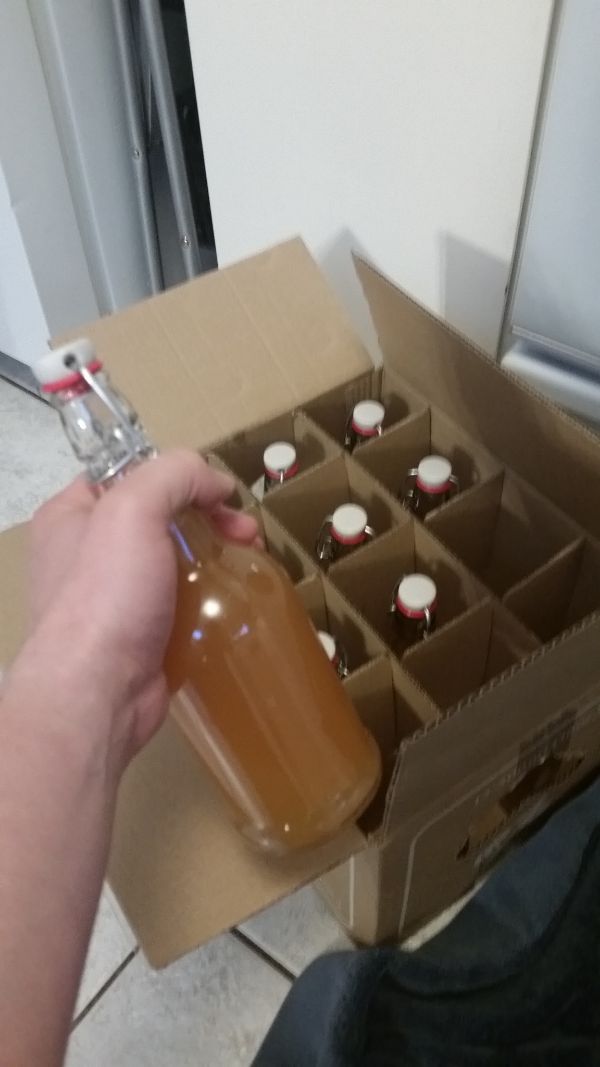Step-by-step recipe for a basic apple cider, one of the easiest fermented drinks to make at home.
Originally Posted: August 15, 2020

Table of Contents
Quick Specs
- OG = 1.035 – 1.045
- ABV: ~4.6% – 5.9%
- Taste Profile: Dry and apple-y if you let it ferment completely, sweet if you arrest fermentation or back-sweeten after fermentation.
- Time: 2 – 4 weeks
- Yield: Depends on batch size.

Intro
Traditional apple cider (often called “hard cider” in the US) is the easiest alcoholic drink there is to ferment at home. All you need is juice, yeast, and a fermenter for the most basic cider, though it can be advantageous to add yeast nutrient (even just a handful of raisins), extra sugar, or flavoring spices.
Brief History
Historic cider production has roots in nearly every region of Europe, especially in regions where the grape vine has a harder time flourishing. Cider culture is especially ingrained in southern England and northern France, and both apple and pear ciders can be found on both sides of the English Channel.
Some of the best apple ciders are made with “cider apples”, which tend to be more bittersweet than culinary apples (even crab apples make a delicious cider). A cider made purely of pear juice is known as a “perry”, though some purists say that a true perry must be made specifically out of “perry pears”.
Both apple and pear cider can be distilled into apple or pear brandies, with Calvados brandy being a famous example from the Calvados Department of France.

Ingredients
- Apple juice
- Alternatives I’ve had success with include pear juice, tart cherry juice, and blueberry juice
- Yeast of your choice (I’ve had good experiences with a wide variety of cider, ale, and champagne yeasts. Another option is to use wild yeast from the skins of fresh-picked apples)
- Yeast nutrient
- 5 – 7 cloves (optional)
- Cinnamon stick (optional)
- Yeast nutrient (optional, can help the yeast along in its job)
Equipment
Instructions
- Mix all your ingredients together. Do so in a sanitized pot if you wish to heat the mixture and add extra sugars.
- Put it all in a sanitized fermenter and until primary fermentation subsides. You can either rack into a secondary fermenter or you can bottle it (still or carbonated, your choice).
- Adding the optional cloves and cinnamon makes this an Apple Pie Cider.
I told you cider was the easiest thing to make.
Variations
When I was first starting out making fermented beverages, I used to go to Trader Joe’s or Fred Meyer and buy various all-natural juices to test them out. My best results came from making a cherry cider from all-natural cherry juice and a pear cider from all-natural pear juice. Basically, you can ferment any sugar-rich juice as long as it doesn’t contain preservatives like potassium sorbate. Citric acid as a preservative won’t be a problem.

My worst result came from trying to ferment papaya juice, though I’m not sure if that’s because there’s something in papaya that makes a papaya cider unpalatable or if something just went wrong with the fermentation. I haven’t tried making it again, and according to my notes I wrote “good for filling water balloons with and throwing them at individuals you dislike”.

Apple Pressing
If you have access to a lot of fresh, organic apples, you can take things a step further and make this: a wild yeast-fermented cider made from fresh-pressed apples. It’s slightly more time- and equipment-intensive, but it’s very rewarding.

Tips & Tricks
If you want a sweeter cider, you can taste it regularly until you get a level of sweetness you like and then halt fermentation using potassium sorbate and potassium metabisulfite. If you want a full-strength cider that’s sweet, you can let fermentation come to a stop on its own, then add sorbate, metabisulfite, and a sugar source like honey until you get your desired sweetness.
Note: If you add these preservatives, you won’t be able to carbonate your cider via the “bottle conditioning” method, as all the yeast will be dead or in stasis and won’t be able to produce CO2. You can still carbonate the cider through “force carbonation” if you have kegging equipment or even one of those GrowlerWerks pressurized growlers.
Sulfur Smell
A common problem while fermenting ciders often solves itself; because apple juice doesn’t have everything yeast needs to survive, fermentation often gives off a sulfur-y smell. Sometimes adding yeast nutrient at the beginning is enough to prevent this, but not always. The sulfur smell should dissipate on its own over time, but if it doesn’t there are several things you can do.
The first thing to try is to allow the cider to cascade down the side of your secondary fermenter when you siphon. This exposes more surface area to the air, allowing the sulfur smell to be driven off.
The other thing you can try is to drop a sanitized penny or other piece of copper into the fermenter. Copper reacts with sulfur compounds and very quickly removes them from your cider. This is also the reason why most distillation systems have copper parts.

Possible Culinary Uses
Traditionally, apples were considered a harvest-time food, which is the origin of such Fall traditions as caramel apples, bobbing for apples, and fresh-pressed and spiced juice. Pigs were also slaughtered in Autumn to provide both fresh meat for harvest-time festivals and cured meats to last through the winter. Because of this, apples and pork were often served in the same meal (think of the common image of a suckling pig with an apple in its mouth).
I’ve seen many recipes for cider-braised pork dishes, though personally I’m more curious about doing such a dish with my apple cyser mead.




